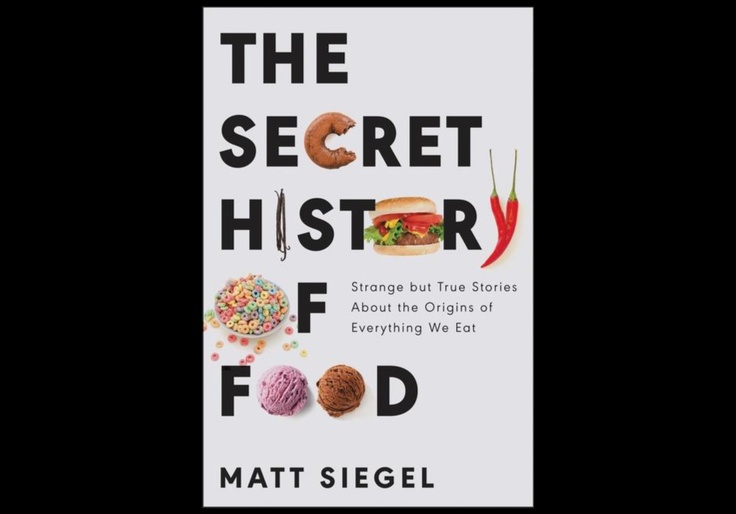Thousands of book titles start with "The Secret History of… ." It's dishy. When they finish the phrase with something we can stuff in our pieholes, a hungry audience is almost guaranteed. But is it secrets that Matt Siegel divulges in The Secret History of Food: Strange but True Stories About the Origins of Everything We Eat? And, for that matter, how does it manage to chronicle the edible universe at a thickness less than a Cuban sandwich?
Both questions can be answered at once. This is Siegel's selective take on what conscientious eaters ought to know about common comestibles—things that are not so much kept under wraps as they are perhaps under-acknowledged or just plain incorrect. He wisely unpacks his exposition per foodstuff and its related human behavior rather than by era or geographic location, which allows the author to pepper a single page with references to, say, Sanskrit text and genetic fruit fly research.
The approach certainly keeps things interesting, whether the topic is tomatoes, corn, convenience foods, holiday entrées, fast food chains, chilies, spices, olive oil, vanilla, or herbal supplements—all of which are served up in the book. Siegel charts his course early on, with a quote from the late British historian Reay Tannahill (Food in History): "The pursuit of more and better food has helped to direct—sometimes decisively, more often subtly—the movement of history itself."
We are generally aware that honey is hygroscopic and antibacterial, for example; we ought to understand that the particular type of honey as labeled on any jar might not completely describe the viscous substance inside it. In his "Honey Laundering" chapter, Siegel is not talking clover vs. buckwheat, but about the traces of lead and antibiotics found in some imported filtered honeys, and the traces of poison ivy nectar and industrial waste found in some honeys commercially produced in the United States. (Pollinating bees really get around.)
We learn that the ancients used honey to cast out evil spirits. Hitler's wounded troops received a gift of "honey" from their Führer—albeit an imitation made from beet syrup and food coloring. As of 2007, honey was FDA-approved to help heal first-degree burns and surgical wounds.
Such revelations are not intended as turnoffs, but to prove the author's point: that honey, and its history, are "not as wholesome as one might think," he writes. "For every connotation of love or godliness in its sugarcoated history, there's an opposite connotation of death, pain, or the macabre."
The tone of this former English professor with a marketing background is intentionally anti-academic, even with his obvious diligence to documentation and sourcing, i.e., copious footnotes and a fat bibliography. He relies on a certain rhythm of punchlines and supposition that at times warrants a rim shot. Extracted from his "Children of the Corn" chapter:
Yet for some reason our ancestors saw potential in this lowly grass and kept replanting it, choosing only the seeds with the most attractive traits—say, height, girth, tenderness, and disease resistance—until it grew into a tall and dependable grain they could live on. So it was a lot like dating in high school.
Ba-dum bum. "There is a ton of irony in history," he explained to me in a phone interview. "We need a dose of comic relief from what we are currently facing. I couldn't help but smirk and laugh out loud when I made these connections."
Some of those associations are indeed amusing. In pre-colonial England: pie as greasy vessel for preserving meat. Colonists in America: pie as handy treat, filled with apples. Insults were exchanged across the Atlantic, in print! Other connections are downright disturbing. Siegel finds similarities of rage against the Industrial Revolution in the writings of 19th century dietary reformer Sylvester Graham (of graham cracker and whole-wheat flour fame) and Unabomber Ted Kaczynski. A few breakfast-focused pages later, the author suggests that John Harvey Kellogg (of eugenicist, Corn Flakes fame) could have been London's Jack the Ripper.
As lively as the text is, old photos and infographics would have enriched the effort. Siegel has plenty in hand, he says, should a future printing provide extra space. And in describing the methods of modern food stylists, he might have fallen into the same "truthiness" trap that prompted him to set the record straight elsewhere. Personal lubricants "to make foods look glossy" and shaving cream as an ice cream stand-in are not used by anyone who's styling for editorial or commercial publication these days. Real food is required, and in demand. Where a touch of shine is needed, an application of edible oil does the trick.
Siegel's passion for his subject is definitely real. An initial thread of research on ice cream's role in wartime led to this creation of savory stories, with a side of tongue in cheek. Pull up a chair and dig in.
The Secret History of Food: Strange but True Stories About the Origins of Everything We Eat
By Matt Siegel
Ecco, 288 pp., $27.99
Bonnie S. Benwick is a Washington freelance editor and recipe tester. She retired as deputy editor and recipes editor of the Washington Post food section in 2019.
